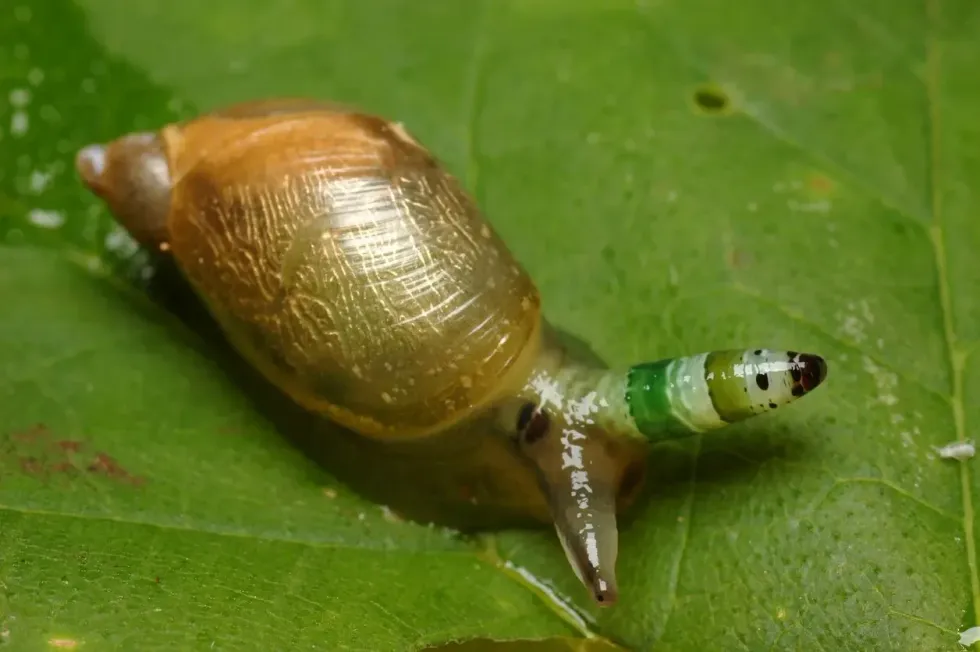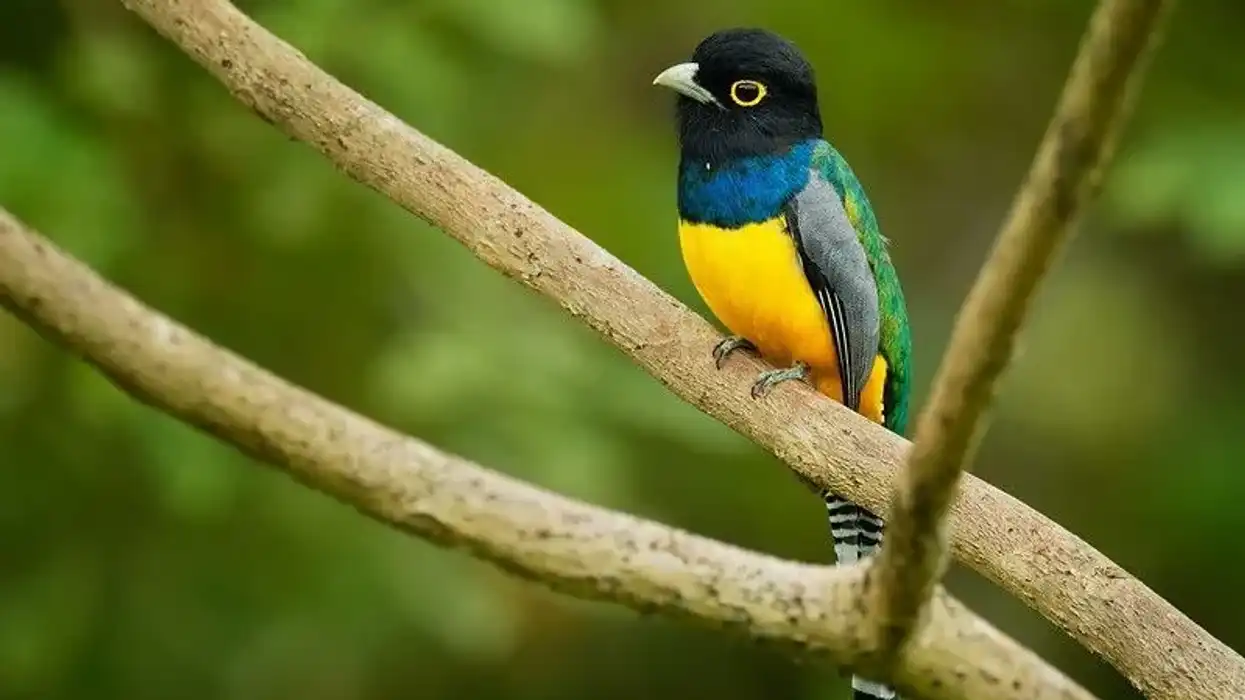This parasitic flatworm (Leucochloridium paradoxum) is commonly found throughout Europe and North America. They mainly use a snail or a bird as their primary and secondary host respectively.
Through their hosts, they are able to find nourishment, as they feed on the body fluids provided by their hosts. Once inside the bird, these parasites turn into adults and lay eggs, which come out through the bird's excrement.
Once the snail eats them, they travel towards the tentacles of the snail, and turn them into a blind, pulsating, and colorful creature, resembling a caterpillar.
Birds, then, confusing the snail to be a caterpillar, eat it. Parasites turn into adults by feeding off the birds that have ingested their primary host.
The life cycle restarts when an unaware snail consumes the feces filled with eggs of these parasites and a bird eats the snail. Some birds that eat snails include blackbirds and robins.
For more relatable content, check out these flatworm facts and stick bug facts for kids.
Green-Banded Broodsac Interesting Facts
What type of animal is a green-banded broodsac?
The green-branded broodsac (Leucochloridium paradoxum) is a type of parasitic worm that is found in bird droppings and is ingested by its primary host, snails. It then makes a home in the tentacles of the snail, pulsating throughout, which attracts birds, who then attack and feed on these infected creatures. Birds then turn into their secondary hosts.
Thrushes and robins commonly eat snails. Zombie snails are real; they are formed when a parasite takes control of a normal snail. They are a type of worm.
What class of animal does a green-banded broodsac belong to?
The green-banded broodsac is a type of snail that falls into the Rhabditophora class.
How many green-banded broodsacs are there in the world?
In terms of accurate numbers, there is no verifiable data present that can accurately attest to the current number of green-branded broodsacs present in the world.
Where does a green-banded broodsac live?
Within Europe, some of the most prominent places that this parasite was found include Germany, Belarus, Poland, Denmark, Norway, Sweden, and the Netherlands. Some of them have also been spotted in places such as the United States, Japan, the UK, and St. Petersburg, Russia.
What is a green-banded broodsac's habitat?
Green-branded broodsacs (Leucochloridium paradoxum) are mainly present in wet environments that contain a lot of moisture. Some of the primary habitats for this creature include marshes and forests.
Who do green-banded broodsacs live with?
Groups of larvae are deposited in the feces of birds, after which they are consumed in bulk by snails, who unbeknownst to them, have just signed up to become prey for many birds. This parasite is ingested in large quantities at times, therefore eggs or full-grown parasites once ingested, tend to stick together in the snail.
How long does a green-banded broodsac live?
It is not fully known how long an adult parasite can survive. However, there have been records of snails surviving close to a year even with a parasitic worm forming a long sac over their eyestalks. They survived by using a pair of eyes present on their tentacles.
How do they reproduce?
When it comes to reproduction, the green-banded broodsac (Leucochloridium paradoxum) reproduces asexually. Adults are hermaphroditic, nevertheless, some can cross-fertilize with others if they are in close proximity to each other. The life cycle continues when they release the eggs into the rectum of the bird, and the eggs are then released by the bird into the ground.
What is their conservation status?
The IUCN Red List has not listed this parasite (Leucochloridium paradoxum) in its conservation directory. Therefore, the conservation status of this species is currently unknown.
Green-Banded Broodsac Fun Facts
What do green-banded broodsacs look like?
These parasitic worms have green bands that are generally filled with dark spots that either dark brown or black. They have a reddish-brown or dark brown tip. They are an infected intermediate host. The sporocyst has a swollen and long sac filled with cercariae.

*The picture is of a snail, not the parasite.
How cute are they?
Most individuals don't consider these creatures to be particularly cute. This is due to the inherent nature, where they harm their host.
How do they communicate?
It is still majorly unknown how this parasite communicates with others. However, we do know that it is very controlling and manipulative.
It is able to sneak into a snail by camouflaging itself in bird droppings.
After snails have consumed a certain amount of larvae, these parasites engage in aggressive mimicry by taking over the left eyes talk and right eye stalk of the snail and pulsating at a fast rate. They force the snail to move towards the light so that birds may notice the tentacles, that look like a caterpillar.
How big is a green-banded broodsac?
In terms of length, this worm is estimated to be around 0.3 in (0.8 cm). In comparison with a caterpillar whose length averages between 0.03–0.5 in (1-14 mm) in length, they are slightly bigger.
How fast can a green-banded broodsac fly?
The green-banded broodsac parasite does not fly. It is a parasitic flatworm that moves just like a caterpillar.
How much does a green-banded broodsac weigh?
The exact weight of a green-banded broodsac has not been currently verified. However, due to their ability to be ingested by snails, we can ascertain that this flatworm is pretty small in size.
What are the male and female names of the species?
There are no specific terms that differentiate green-banded broodsac adults. However, when it comes to their gametes, female gametes are referred to as eggs or ova, whereas male gametes are referred to as sperm.
What would you call a baby green-banded broodsac?
There are no special terms aside from a baby green-banded broodsac. However, at an early stage, they can also be referred to as larva or egg.
What do they eat?
This parasite mainly feeds on the body fluids that are present inside of its host, the snail or the bird. They are termed are parasites due to the fact that they are eating a portion of a living bird or a snail.
Are they dangerous?
This parasite mainly causes harm to its primary host, the snail, and its secondary host, the bird that ingests the snail. This parasite cannot harm humans; even if a human accidentally ingests the eggs of this parasite, they will barely be able to affect the human body.
Would they make a good pet?
The green-banded broodsac or Leucochloridium paradoxum is a parasite. Therefore, it is not a type of creature that should ideally be kept as a pet.
Did you know...
Leucochloridium is the parasite that turns a normal snail into a zombie snail.
Parasitic broodsac worms do need two hosts to survive and complete their life cycle.
Green-banded broodsacs and snails
The relationship between the green-banded broodsac and snails is parasitic. This means that the green-banded broodsac (parasite) benefits when its host, either the snail or the bird, is harmed.
After they enter the body of the snail, they make the tentacles resemble the shape of a caterpillar. Further, they partially blind them and force them to go into the sun. All of this causes birds to attack and eat the creatures.
Can green-banded broodsacs infect humans?
This parasite can enter humans. However, they are not meant to exist and survive inside the human body, therefore they bring no harm to human adults or kids.
Here at Kidadl, we have carefully created lots of interesting family-friendly animal facts for everyone to discover! For more relatable content, check out these pill bug facts and kudzu bug facts pages.
You can even occupy yourself at home by coloring in one of our free printable green-banded broodsac coloring pages.









